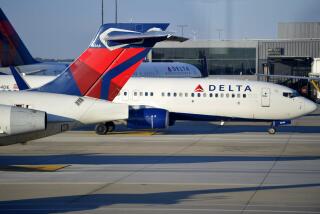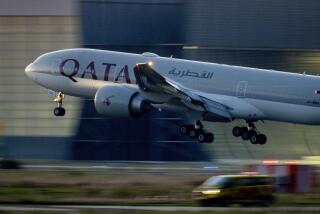If the Plane Bucks, It’s Better to Be Buckled-Up : Airlines: The real danger when flying is from unexpected moderate to severe in-flight turbulence.
- Share via
If you’re like most airline passengers, you board your airplane, stow your carry-on baggage, take your seat and fasten your seat belt.
About two to three minutes into most flights, the captain will turn off the “Fasten Seat Belt” sign. Being an obedient passenger, you unbuckle your seat belt.
That could be a big mistake. When you least expect it, the plane could be buffeted by moderate to severe turbulence, and you could seriously injure yourself.
Although most airlines don’t like to publicize it, there is a real danger of passenger accidents resulting from in-flight turbulence.
On Nov. 24, 1983, an Air Canada L-1011 flying above South Carolina encountered turbulence. Twenty-five passengers were injured, five of them seriously.
On March 3, 1986, near Honolulu, nine passengers were hurt (two seriously) on a United Airlines 747 that was hit by turbulence.
On July 13, 1986, an Eastern Airlines A300 flying near West Palm Beach, Fla., was rocked by turbulence. Thirty passengers were injured.
On Nov. 11, 1987, a Pan Am A300 flying across the Atlantic was also hit by severe turbulence. Thirty-five passengers were hurt.
In almost every case, the passengers injured were not wearing seat belts when the turbulence occurred.
Officially, these are classified as “Part 121” accidents, meaning an accident in which there are passenger or crew injuries or substantial damage to an aircraft.
There are, of course, different kinds of turbulence. Turbulence can be created by weather fronts and storms, by the vortices of exhaust from airplanes in front of you, or the most severe--and usually unexpected--kind: CAT, or clear-air turbulence.
Weather experts say that turbulence occurs when warm and cold air masses collide near the jet stream at the cold/warm air boundary. They will also tell you that turbulence occurs more often during the winter months, due to seasonally colder air temperatures.
“Still, forecasting turbulence is an iffy business,” according to Ken Plunkett, director of research for the nonprofit Aviation Safety Institute in Worthington, Ohio. “The FAA will issue reports of suspected turbulence, but more often than not they are general in nature.”
For example, the FAA might warn pilots of suspected turbulence in a large geographic grid stretching from Michigan to Florida at altitudes 18,000 to 47,000 feet.
Other turbulence warnings come from “Pireps”--pilot reports filed by captains flying either immediately in front of you or in the general vicinity of your airspace.
“But the problem,” said John Galipault, president of ASI, “is that no one agency, airline or pilot can really anticipate when turbulence will occur. Airlines are very good at making people fasten their seat belts for takeoffs and landings, but what about in-flight?
“Most fliers take for granted that once an aircraft is flying at its cruising speed, nothing short of a crash will significantly disrupt the flight. That’s not true. Few airlines promote the idea of keeping passenger seat belts fastened securely at all times because they’re afraid it might worry passengers.”
Actually, you should be worried about what could happen if you don’t keep your belt fastened during the flight.
Plunkett recently studied data from the National Transportation Safety Board indicating that nearly 25% of all airliner accidents between 1983 and 1988 involved in-flight turbulence.
Not only were passengers seriously injured, but flight attendants were especially vulnerable.
In many cases, an airplane might suddenly lose altitude. When that happens, flight attendants in the aisles--as well as unrestrained passengers--hit the ceiling . . . literally.
As the pilot fights to regain control and return to altitude, those flight attendants and passengers are often thrown to the floor.
Again, having your seat belt fastened is only part of the solution. You must fasten it tightly. “On one flight when we hit turbulence,” said Lenore Kadish, a TWA flight attendant, “an elderly woman who had fastened her seat belt was pulled out of her seat by a sudden loss of altitude.
“When she hit the floor, it started to happen again. The only thing that saved her was that other passengers grabbed her and held her down until things smoothed out.”
As might be expected, policies about seat belts vary from airline to airline. Some airlines politely suggest that you keep the belts loosely fastened. Other airlines insist that their flight attendants adhere to a strict employee seat-belt rule.
“I was astounded when I came to work for this airline,” said flight attendant Susan Marshall, who joined Delta Airlines after flying for another carrier for many years.
“My previous airline was very lax about what flight attendants could and couldn’t do at various stages of the flight. Delta is unbelievably cautious about flight attendants wearing seat belts.
“For example, we are not allowed to get up from our seats until the seat-belt sign goes off. The same rule applies when the plane is taxiing. It’s an important rule, and I’d like to see other airlines adopt it.”
But what about new rules for passengers?
For the moment, to protect yourself, don’t wait for the FAA. Abide by your own rules.
Unless you have to go to the bathroom, keep your belt tightly fastened. And on longer flights, if you want to sleep, fasten your seat belt on the outside of your blanket, where it is clearly visible to flight attendants.
If you find yourself in severe turbulence--and assuming you’ve already fastened your seat belt--quickly bury your head in your arms. That way, you can also minimize the damage caused by objects flying through the cabin.
More to Read
Sign up for The Wild
We’ll help you find the best places to hike, bike and run, as well as the perfect silent spots for meditation and yoga.
You may occasionally receive promotional content from the Los Angeles Times.






